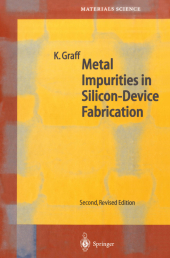 Neuerscheinungen 2012Stand: 2020-01-07 |
Schnellsuche
ISBN/Stichwort/Autor
|
Herderstraße 10
10625 Berlin
Tel.: 030 315 714 16
Fax 030 315 714 14
info@buchspektrum.de |

Klaus Graff
Metal Impurities in Silicon-Device Fabrication
2. Aufl. 2012. xv, 270 S. XV, 270 p. 235 mm
Verlag/Jahr: SPRINGER, BERLIN 2012
ISBN: 3-642-62965-2 (3642629652)
Neue ISBN: 978-3-642-62965-5 (9783642629655)
Preis und Lieferzeit: Bitte klicken
This up-to-date monograph provides a thorough review of the relevant data and properties of the transition-metal impurities generated during silicon-sample and device fabrication. The different mechanisms responsible for contamination are discussed, and a survey is given of their impact on device performance. The specific properties of the main and rare impurities in silicon are examined, as well as the detection methods and requirements in modern technology. This new edition includes important recent data and many new tables.
1. Introduction.- 2. Common Properties of Transition Metals.- 2.1 General Behavior.- 2.2 Contamination of Silicon Wafers.- 2.2.1 Solid Phase.- 2.2.2 Liquid Phase.- 2.2.3 Vapor Phase.- 2.3 Impact on Device Performance.- 2.3.1 Dissolved Transition Metals.- 2.3.2 Precipitated Transition Metals.- 3. Properties of Transition Metals in Silicon.- 3.1 Solubilities.- 3.2 Diffusivities.- 3.3 Dissolved Impurities.- 3.3.1 Point Defects.- 3.3.2 Complexes.- 3.4 Precipitated Metals.- 3.4.1 Volume Precipitates.- 3.4.2 Surface Precipitates - Haze.- 3.4.3 Haze Phenomena.- 4. Properties of the Main Impurities.- 4.1 Iron.- 4.1.1 Solubility.- 4.1.2 Diffusivity.- 4.1.3 Behavior During Heat Treatment.- 4.1.4 Electrical Activity.- 4.1.5 Properties of the Precipitates.- 4.1.6 Known Impurity Sources, and Common Concentrations.- 4.1.7 Avoidance of Contamination.- 4.2 Nickel.- 4.2.1 Solubility.- 4.2.2 Diffusivity.- 4.2.3 Behavior During Heat Treatment.- 4.2.4 Electrical Activity.- 4.2.5 Properties of the Precipitate.- 4.2.6 Known Impurity Sources, and Common Concentrations.- 4.2.7 Avoidance of Contamination.- 4.3 Copper.- 4.3.1 Solubility.- 4.3.2 Diffusivity.- 4.3.3 Behavior During Heat Treatment.- 4.3.4 Electrical Activity.- 4.3.5 Properties of the Precipitate.- 4.3.6 Known Impurity Sources and Common Concentration.- 4.3.7 Avoidance of Contamination.- 4.4 Molybdenum.- 4.4.1 Solubility.- 4.4.2 Diffusivity.- 4.4.3 Behavior During Heat Treatment.- 4.4.4 Electrical Activity.- 4.4.5 Properties of the Precipitate.- 4.4.6 Known Impurity Sources and Common Concentrations.- 4.4.7 Avoidance of Contamination.- 4.5 Palladium.- 4.5.1 Solubility.- 4.5.2 Diffusivity.- 4.5.3 Behavior During Heat Treatment.- 4.5.4 Electrical Activity.- 4.5.5 Properties of the Precipitate.- 4.5.6 Known Impurity Sources and Common Concentrations.- 4.6 Platinum.- 4.6.1 Solubility.- 4.6.2 Diffusivity.- 4.6.3 Behavior During Heat Treatment.- 4.6.4 Electrical Activity.- 4.6.5 Properties of the Precipitate.- 4.6.6 Known Impurity Sources and Common Concentrations.- 4.6.7 Avoidance of Contamination.- 4.7 Gold.- 4.7.1 Solubility.- 4.7.2 Diffusivity.- 4.7.3 Behavior During Heat Treatment.- 4.7.4 Electrical Activity.- 4.7.5 Properties of the Precipitates.- 4.7.6 Known Impurity Sources and Common Concentrations.- 4.7.7 Avoidance of Contamination.- 5. Properties of Rare Impurities.- 5.1 Scandium.- 5.2 Titanium.- 5.3 Vanadium.- 5.4 Chromium.- 5.5 Manganese.- 5.6 Cobalt.- 5.7 Zinc.- 5.8 Zircon.- 5.9 Niobium.- 5.10 Ruthenium.- 5.11 Rhodium.- 5.12 Silver.- 5.13 Cadmium.- 5.14 Hafnium.- 5.15 Tantalum.- 5.16 Tungsten.- 5.17 Rhenium.- 5.18 Osmium.- 5.19 Iridium.- 5.20 Mercury.- 6. Detection Methods.- 6.1 Detection of Total Impurity Content.- 6.1.1 Neutron Activation Analysis.- 6.1.2 Mass Spectrometers, Secondary Ion Mass Spectrometers.- 6.1.3 Atomic Absorption Spectroscopy.- 6.1.4 Vapor-Phase Decomposition.- 6.1.5 Inductively-Coupled Plasma Spectroscopy.- 6.1.6 Total-Reflection X-Ray Fluorescence Analysis.- 6.2 Detection of Dissolved Impurities.- 6.2.1 Deep Level Transient Spectroscopy.- 6.2.2 Carrier Lifetime.- 6.2.3 Diffusion Length.- 6.3 Detection of Precipitates.- 6.3.1 Haze Test.- 7. Requirements of Modern Technology.- 7.1 Reduction of Contamination.- 7.1.1 Control of Ingots.- 7.1.2 Process Control.- 8. Gettering of Impurities.- 8.1 Gettering Mechanisms.- 8.2 Control of Gettering Efficiency.- 8.2.1 Conventional Methods.- 8.2.2 Palladium Test.- 8.2.3 Iron Test.- 9. Conclusion and Future Trends.- References.


